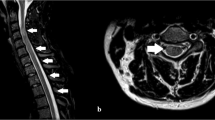Abstract
Background
Toxocariasis is a common parasitic infection worldwide. Although it can present as several clinical syndromes, neurological manifestation is rare. Only a few reports are available on spinal cord involvement of toxocariasis.
Case summary
We report a case that presented with gait disturbance due to progressive lower limb spasticity. The patient had had visceral toxocariasis infection 8 years before. A spine magnetic resonance image (MRI) showed syringomyelia along the entire thoracic cord with small nodular enhancing lesions in the mid-portion of the syrinx, which led to the suspicion of ependymoma. Surgical mass removal was performed. However, histopathological examination of the mass did not show any malignant cells; instead, there were numerous axonal retraction balls with an eosinophilic granular body-like appearance. The serum antibody titer against toxocariasis was borderline high. Taken together, these observations led to a diagnosis of Toxocara infection, and the patient was treated with albendazole.
Conclusion
To the best of our knowledge, this is the first case report of tumor-like spinal toxocariasis involving extensive lesions. A solid enhancing mass with accompanied syrinx and hemorrhage might be a Toxocara infection. It can easily be diagnosed with serologic tests and simply be treated with oral albendazole if suspected.


Similar content being viewed by others
Availability of data and material
The data that support the findings of this case are available from the corresponding author upon a reasonable request.
References
Magnaval J-F, Glickman LT, Dorchies P, Morassin B (2001) Highlights of human toxocariasis. Korean J Parasitol 39:1. https://doi.org/10.3347/kjp.2001.39.1.1
Romero Núñez C, Mendoza Martínez GD, Yañez Arteaga S et al (2013) Prevalence and risk factors associated with Toxocara canis infection in children. Sci World J 2013:572089. https://doi.org/10.1155/2013/572089
Magnaval J-F, Michault A, Calon N, Charlet J-P (1994) Epidemiology of human toxocariasis in La Réunion. Trans R Soc Trop Med Hyg 88:531–533
Rubinsky-Elefant G, Hirata CE, Yamamoto JH, Ferreira MU (2010) Human toxocariasis: diagnosis, worldwide seroprevalences and clinical expression of the systemic and ocular forms. Ann Trop Med Parasitol 104:3–23. https://doi.org/10.1179/136485910X12607012373957
Park H-Y, Lee S-U, Huh S et al (2002) A seroepidemiological survey for toxocariasis in apparently healthy residents in Gangwon-do, Korea. Korean J Parasitol 40:113–117
Macpherson CNL (2013) The epidemiology and public health importance of toxocariasis: a zoonosis of global importance. Int J Parasitol 43:999–1008
Glickman LT, Schantz PM (1981) Epidemiology and pathogenesis of zoonotic toxocariasis. Epidemiol Rev 3:230–250
Lee IH, Kim ST, Oh DK et al (2010) MRI findings of spinal visceral larva migrans of Toxocara canis. Eur J Radiol 75:236–240. https://doi.org/10.1016/j.ejrad.2009.04.024
Umehara F, Ookatsu H, Hayashi D et al (2006) MRI studies of spinal visceral larva migrans syndrome. J Neurol Sci 249:7–12. https://doi.org/10.1016/j.jns.2006.05.057
Xinou E, Lefkopoulos A, Gelagoti M et al (2003) CT and MR imaging findings in cerebral toxocaral disease. AJNR Am J Neuroradiol 24:714–718
Deshayes S, Bonhomme J, de La Blanchardière A (2016) Neurotoxocariasis: a systematic literature review. Infection 44(5):565–574. https://doi.org/10.1007/s15010-016-0889-8
Woodhall DM, Eberhard ML, Parise ME (2014) Neglected parasitic infections in the United States: toxocariasis. Am J Trop Med Hyg 90:810–813. https://doi.org/10.4269/ajtmh.13-0725
Smith H, Holland C, Taylor M et al (2009) How common is human toxocariasis? Towards standardizing our knowledge. Trends Parasitol 25:182–188
Magnaval JF, Fabre R, Maurirees P et al (1991) Application of the western blotting procedure for the immunodiagnosis of human toxocariasis. Parasitol Res 77:697–702. https://doi.org/10.1007/BF00928685
Wiśniewska-Ligier M, Woźniakowska-Gęsicka T, Sobolewska-Dryjańska J et al (2012) Analysis of the course and treatment of toxocariasis in children-a long-term observation. Parasitol Res 110:2363–2371. https://doi.org/10.1007/s00436-011-2772-y
Taylor MR, Keane CT, O’Connor P et al (1988) The expanded spectrum of toxocaral disease. Lancet 1:692–695
Othman AA (2012) Therapeutic battle against larval toxocariasis: are we still far behind? Acta Trop 124:171–178. https://doi.org/10.1016/j.actatropica.2012.08.003
Sánchez SS, García HH, Nicoletti A (2018) Clinical and magnetic resonance imaging findings of neurotoxocariasis. Front Neurol 9:53. https://doi.org/10.3389/fneur.2018.00053
Author information
Authors and Affiliations
Contributions
Dr. Yeji Lee, Dr. Young seop Song, and Prof. Kim wrote the main manuscript text. Prof. Ji hoon Phi and Prof. In-one Kim drafted and approved the final version of the manuscript. All authors reviewed the manuscript.
Corresponding author
Ethics declarations
Competing interests
The authors declare no competing interests.
Ethics approval and consent to participate
Approval was obtained from the ethics committee of the Seoul National University Hospital.
Consent for publication
Not applicable.
Conflict of interest
The authors have no competing interests to declare that are relevant to the content of this article.
Additional information
Publisher's Note
Springer Nature remains neutral with regard to jurisdictional claims in published maps and institutional affiliations.
Rights and permissions
Springer Nature or its licensor (e.g. a society or other partner) holds exclusive rights to this article under a publishing agreement with the author(s) or other rightsholder(s); author self-archiving of the accepted manuscript version of this article is solely governed by the terms of such publishing agreement and applicable law.
About this article
Cite this article
Lee, Y., Song, Y.s., Phi, J.h. et al. A case report of spinal toxocariasis with extensive tumor-like involvement. Childs Nerv Syst 39, 811–814 (2023). https://doi.org/10.1007/s00381-022-05674-6
Received:
Accepted:
Published:
Issue Date:
DOI: https://doi.org/10.1007/s00381-022-05674-6




